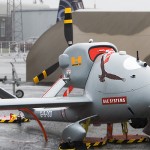 „the market potential on the civil side is considerably larger than the military sector in the long term“
„the market potential on the civil side is considerably larger than the military sector in the long term“
The Civil Aviation Authority granted permission to 100 applications for the domestic use of unmanned drones between January 2010 and September 2011, according to recent freedom of information requests. [1] Drones have been used for a variety of purposes including photography and videography, emergency operations, building surveys, evidence gathering, surveillance and searches.
The documents were released in response to a number of requests made under the Freedom of Information Act in October this year. The names of the organisations granted permission to fly – whether public authorities or private companies – have been censored.
Permission to fly
The CAA was asked to provide information on the number of permissions granted for one-off flights, a series of flights, or blanket permission of a year or more. Two applications were given permission for a limited number of flights. However, 98 of the 100 applications were provided with blanket permission to fly for a year or more.
The use of drones by military forces for surveillance, reconnaissance, and attacks is becoming increasingly commonplace, with concern and criticism also on the rise. Their use in civilian airspace is still relatively novel. Yet the number of drones given permission to fly is higher than expected.
Chris Cole, author of the Drone Wars blog and campaigner against the military deployment of drones, made the freedom of information requests to the CAA. He was surprised with the outcome: „I expected to find that the CAA would have mostly granted one-off permissions to fly drones in UK airspace, with perhaps a handful of blanket permsissions granted each year. However around ten times the number of blanket permisiions are being granted each year. Once this blanket permision has been granted, who monitors what these companies are doing with their drones?“ He estimates that between 40 and 50 organisations made the applications, although it is not possible to say for certain.
Currently, anyone wishing to fly a drone within UK airspace has to make a specific request to the Civil Aviation Authority, who then assess the application and grant or deny permission accordingly. Airspace is currently ’segregated‘ – to use the enthusiasts‘ buzzword – and designated as either civilian or military. Drones are generally confined to areas defined as military, largely because they considered too unsafe to share airspace with other aircraft such as passenger jets.
European initiatives
This may change in years to come. Programmes spearheaded primarily by the European Commission and the European Defence Agency are seeking to fix the technical problems that prevent drones from achieving safety levels equivalent to manned aircraft, as well as altering the regulations that govern the use of drones.
The European Defence Agency alone has overseen research and development related to aerial drones worth nearly €100,000,000. Much of this is intended to benefit the EU’s ‚Single European Sky‘ and the defence industry’s ‚Air4All‘ projects, which are geared towards upgrading air traffic management systems and altering the rules governing the types of aircraft allowed to share the same airspace.
Such changes would mean that the use of drones by private companies and public organisations, for example police forces or border agencies, would likely become far more commonplace.
Eyes in the sky
London’s Metropolitan Police have applied to the CAA for special permission to use drones for surveillance during the Olympics, while BAE Systems, Kent Police, Essex Police and the UKBA are working together as the ‚South Coast Partnership‘ to introduce drones in the sky over Britain’s south east coast. However, as noted by a recent report in The Independent, the use of drones by police forces has had „mixed results“, with only one of four constabularies that trialled drones continuing to use them. [2]
The secrecy afforded to organisations operating drones within the UK currently reflects that surrounding the use of drones in military operations. If, as one market study suggests, „the market potential on the civil side is considerably larger than the military sector in the long term“, both supporters and critics of unmanned technology may have to prepare themselves for more extensive public debate on the matter.
03.01.2012
Sources
[1] Civil Aviation Authority, Response to freedom of information request, 24th November 2011
[2] Jerome Taylor, ‚Drones to patrol the skies above Olympic Stadium‚, The Independent, 25th November 2011
